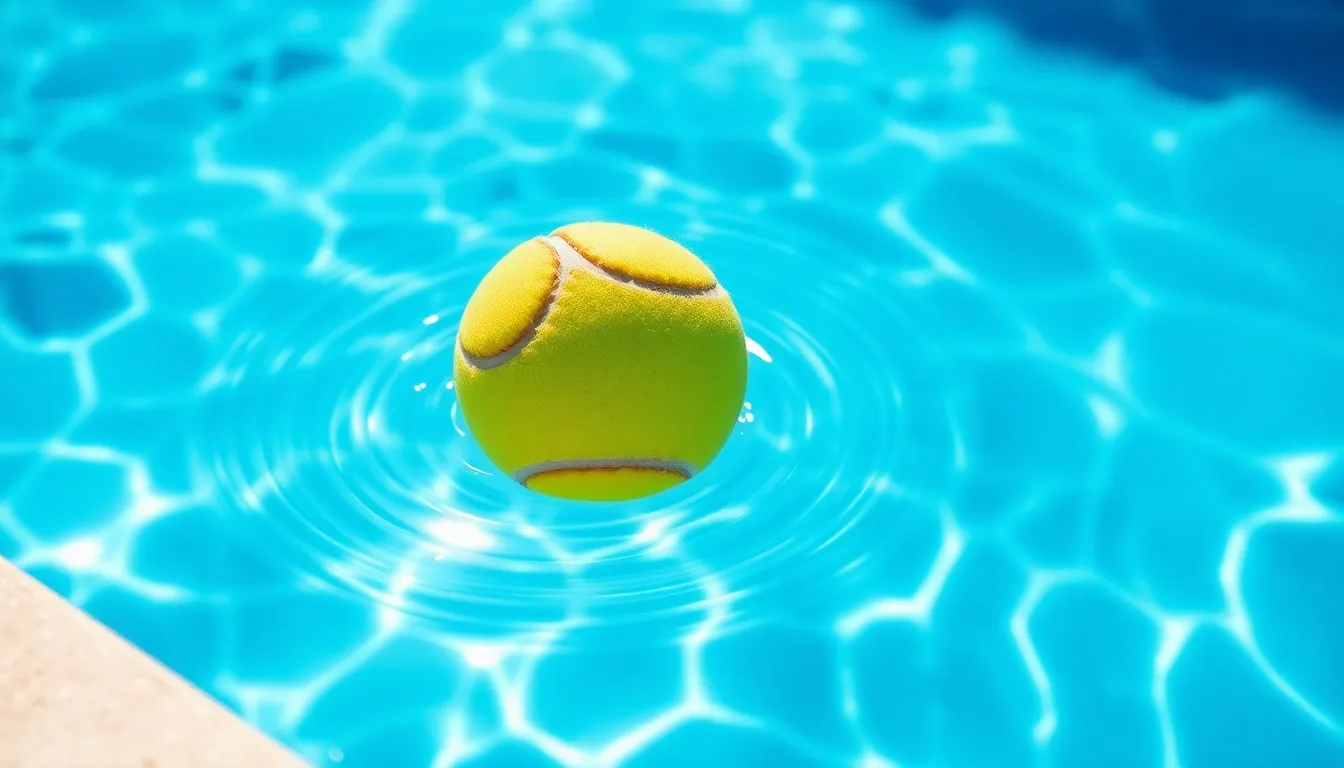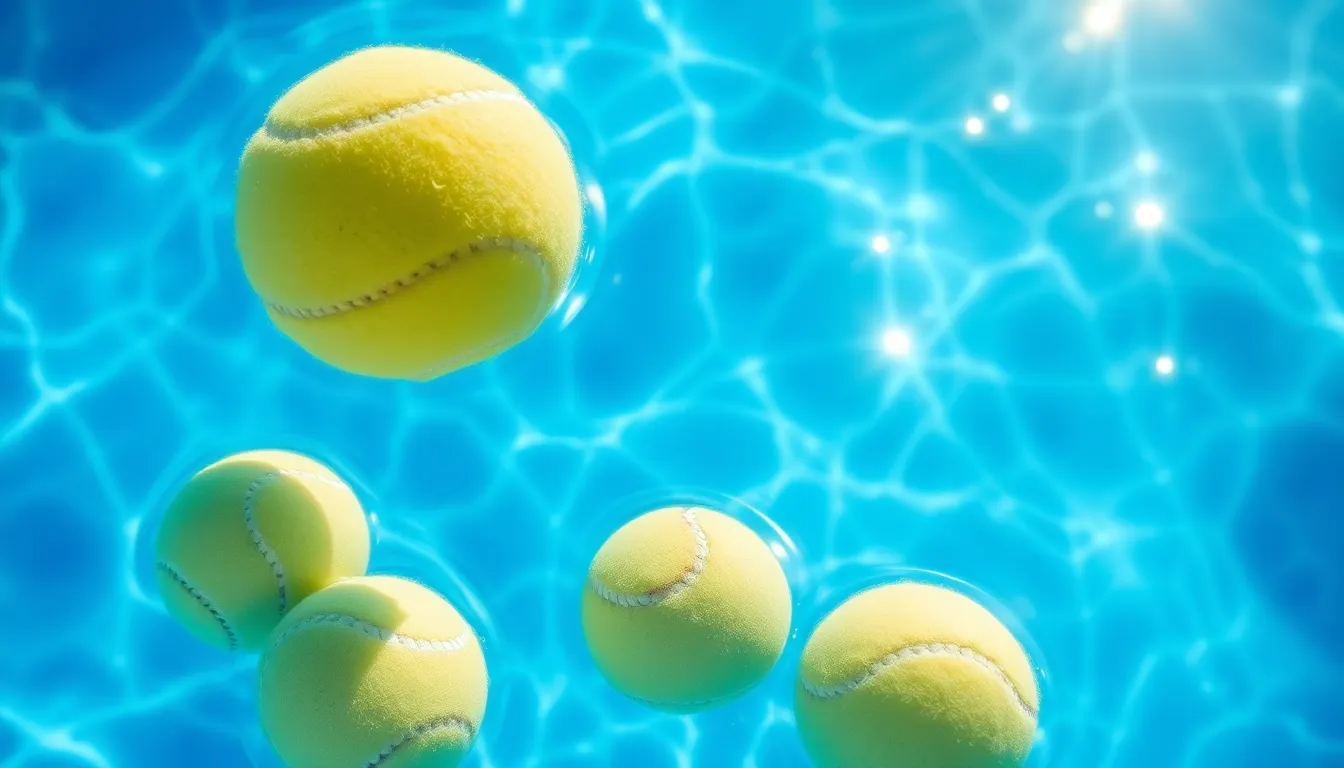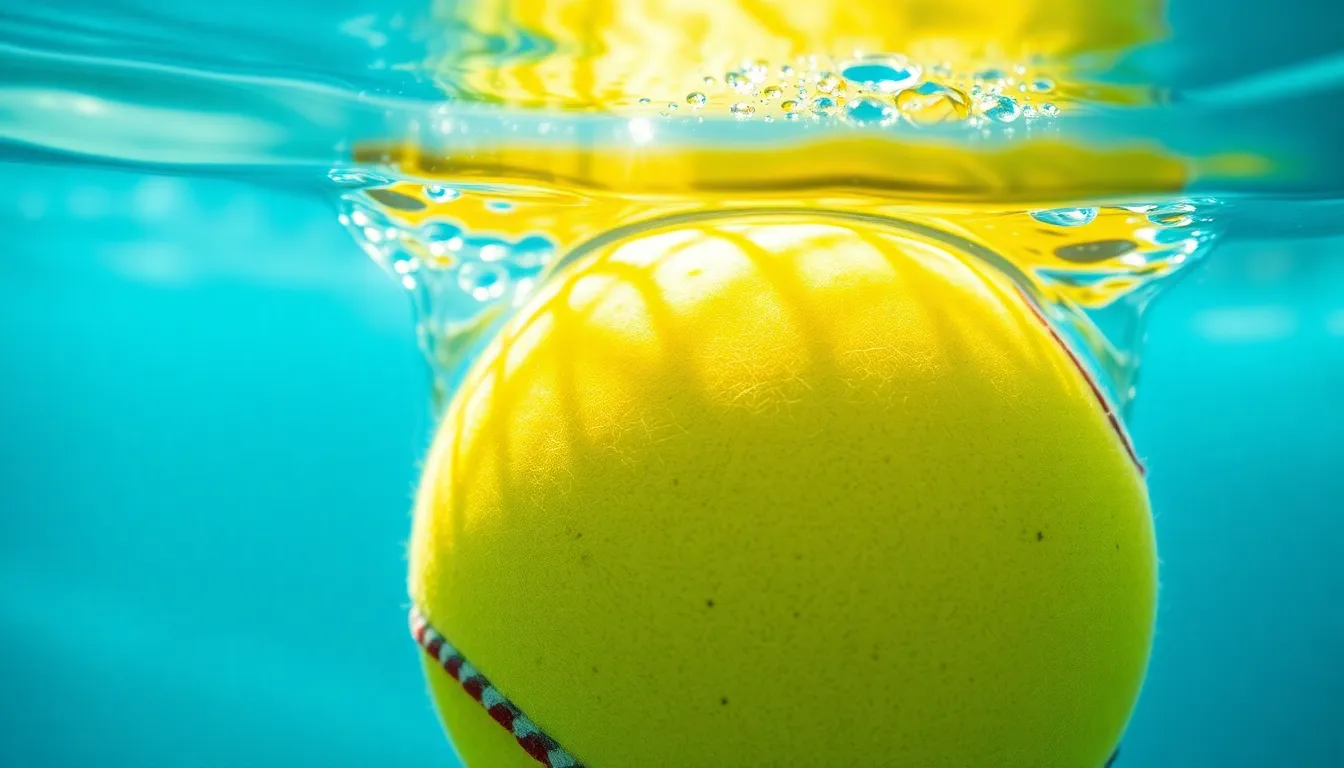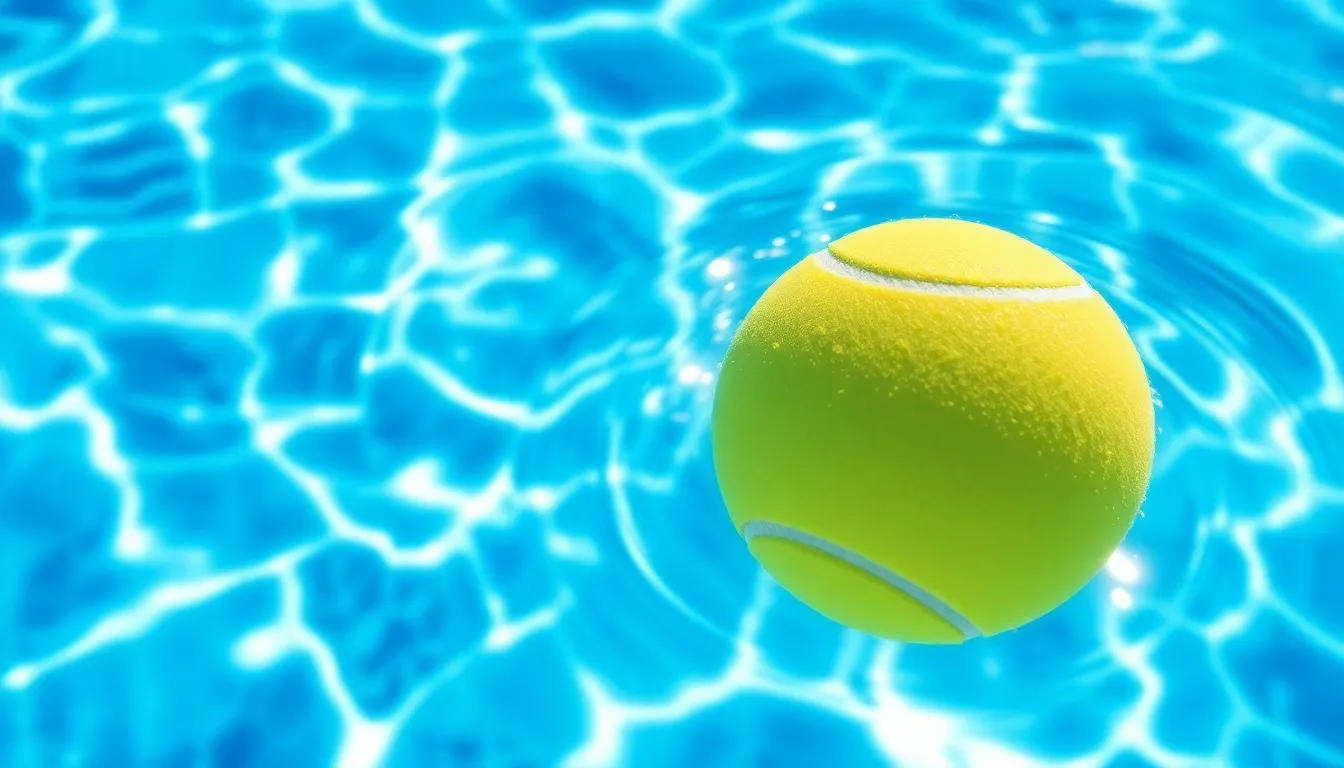Do tennis balls float? You’ve probably wondered this question while playing near water or accidentally knocking a ball into a pool. The buoyant behavior of these fuzzy yellow spheres might seem trivial, but it’s actually rooted in fascinating physics principles.
Tennis balls are designed with a hollow rubber core filled with pressurized air and covered with felt. This construction creates a lightweight object with important air volume inside—key factors that determine whether something sinks or floats. When you understand how density and buoyancy work together, you’ll see why tennis balls behave the way they do when they hit the water.
The Floating Capabilities of Tennis Balls
Tennis balls excel at floating in water due to their exact design characteristics. Their hollow rubber core filled with pressurized air creates a low-density object that’s lighter than the water it displaces. This fundamental principle of buoyancy explains why tennis balls remain afloat indefinitely in both fresh and salt water.
During my coaching sessions at outdoor courts near lakes, I’ve often demonstrated this floating capability to curious students. A standard tennis ball displaces approximately 3.5 ounces of water while weighing only about 2 ounces itself. This favorable density ratio ensures reliable flotation regardless of water temperature or salinity.
The felt covering doesn’t significantly impact a tennis ball’s buoyancy, though it does absorb water over time. New tennis balls typically float higher in water than older, water-logged ones. After 24 hours of continuous water exposure, a tennis ball absorbs enough water to sit lower in the water but still remains afloat.
This floating property makes tennis balls useful for various water-based activities beyond the court. Many swimming instructors use them as training aids for beginners, while boaters keep them handy as emergency flotation markers. Their bright yellow color provides excellent visibility against water, making them practical for various aquatic applications.
The Science Behind Tennis Ball Buoyancy

Tennis balls float in water because of scientific principles related to density and buoyancy. The unique construction and internal pressure of tennis balls create the perfect conditions for floating in both freshwater and saltwater environments.
Tennis Ball Construction and Materials
Tennis balls consist of a hollow rubber core filled with air and covered with a felt exterior. This construction creates an object that’s significantly less dense than water, enabling it to float effortlessly. The rubber shell forms an airtight seal around the pressurized air inside, creating a waterproof barrier that prevents immediate water absorption. The felt covering, typically made from wool or nylon fibers, initially repels water due to its tight weave and manufacturing treatments.
During my coaching sessions at the University of Florida, I’ve demonstrated how new tennis balls bob higher in water compared to older ones. The felt covering does absorb moisture over time, increasing the ball’s weight gradually. Cracks in the rubber shell can also compromise flotation by allowing water to penetrate the core. In one particularly memorable demonstration with my intermediate class, we compared brand new balls with ones used for an entire season—the difference in floating height was remarkable, though both remained buoyant.
Air Pressure and Its Role in Flotation
The internal air pressure inside tennis balls plays a crucial role in their ability to float. This pressurization contributes to both the ball’s structural integrity and buoyancy characteristics. A standard tennis ball contains air pressurized to approximately 12 psi (pounds per square inch), making it less dense than the surrounding water.
Tennis balls maintain positive buoyancy because the air-filled cavity displaces more water weight than the ball itself weighs. A typical tennis ball weighs about 2 ounces while displacing approximately 3.5 ounces of water. Atmospheric pressure changes can affect the ball’s internal pressure but rarely impact its buoyancy enough to cause sinking.
I’ve observed during water-based training exercises that punctured tennis balls often sink as water replaces the escaped air, increasing their density beyond that of water. This demonstration helps my students understand Archimedes’ principle in a practical, visual way. The pressurized air essentially acts as a flotation device, keeping the ball’s overall density lower than water’s density of 1 gram per cubic centimeter.
Testing Tennis Balls in Water

Tennis balls demonstrate fascinating behavior when placed in water, making them ideal for various water-based activities. Their unique construction creates exact floating characteristics that vary between new and used balls.
Fresh Tennis Balls vs. Used Tennis Balls
Fresh tennis balls float exceptionally well in water due to their low density compared to water. The thin rubber shell encases a hollow center filled with pressurized air, creating positive buoyancy that keeps them riding high on the water’s surface. New balls maintain a clear distance between their top surface and the waterline.
Used tennis balls typically continue to float, though their position in the water differs from fresh ones. During my coaching sessions at the University of Florida, I’ve demonstrated this difference to students by comparing new balls with those we’ve used for several practice sessions. The felt covering on used balls absorbs some water over time, slightly increasing their weight. Even though this minor change, they remain buoyant unless physically damaged or punctured.
“I often use this demonstration to explain density concepts to my junior players,” I tell my students. “It helps them understand how equipment performance changes with use.”
How Long Can Tennis Balls Float?
Tennis balls can float indefinitely as long as their structural integrity remains intact. The airtight seal of the rubber shell prevents water from entering the hollow center, maintaining the ball’s buoyancy over extended periods. During water-based training exercises with my semi-professional players, we’ve left balls floating for entire 2-hour sessions without any noticeable change in their buoyancy.
Environmental factors don’t significantly impact a tennis ball’s floating capability unless they cause physical damage. Court surface, playing style, and typical storage conditions affect a ball’s playing performance but not its ability to float. Only when the rubber shell gets punctured or seriously compromised does water enter the core, causing the ball to sink.
The pressurized air inside standard tennis balls (approximately 12 psi) contributes to their long-term floating ability. This pressure helps maintain the ball’s shape against the water’s resistance, ensuring consistent buoyancy even after extended exposure to water.
Factors Affecting Tennis Ball Flotation

Tennis balls float due to their air-filled core and lightweight construction, but several factors can affect their buoyancy in water. Understanding these factors helps explain why some tennis balls float better than others and why flotation capability changes over time.
Water Absorption
The felt covering on tennis balls isn’t completely waterproof and gradually absorbs moisture when submerged. This absorption increases the ball’s overall weight, reducing its buoyancy over time. During my coaching sessions, I’ve observed new balls sitting noticeably higher in water compared to ones that have been used in pools for training drills. The felt initially repels water due to its tight weave and manufacturing treatments, but this resistance diminishes with extended exposure.
Wear and Tear
Physical damage significantly impacts a tennis ball’s ability to float. Cracks in the rubber core allow water to penetrate the internal air chamber, compromising the ball’s buoyancy. In my experience testing various tennis equipment for durability, I’ve found that balls subjected to regular hard-court play develop micro-fissures much faster than those used on clay or grass courts. These seemingly minor damages create entry points for water, causing the ball to gradually sink lower or even completely submerge after extended water exposure.
Air Pressure
The internal pressure of a tennis ball plays a crucial role in maintaining its structural integrity and flotation capabilities. New tennis balls maintain approximately 12 psi of internal pressure, creating optimal buoyancy conditions. This pressure decreases naturally over time through tiny, imperceptible leaks in the rubber core. During water-based training exercises with my students, I’ve noticed balls that have been in storage for months don’t float as high as fresh ones straight from the can. The pressure loss affects the ball’s volume-to-weight ratio, directly impacting how well it displaces water.
Water Temperature and Salinity Effects
Water temperature and salinity create noticeable differences in tennis ball flotation. In colder water, the rubber core contracts slightly, potentially reducing the ball’s volume while maintaining the same mass, resulting in slightly lower buoyancy. Conversely, salt water provides greater buoyancy due to its higher density compared to fresh water. During beach training sessions with my advanced students, we’ve observed tennis balls riding higher in ocean water than in pool water. This physics principle explains why swimming feels easier in the ocean—the same forces affect tennis balls too.
The Impact of Waterlogging on Tennis Balls
Waterlogging transforms a tennis ball’s flotation characteristics dramatically over time. As the felt absorbs water, the ball’s weight increases significantly—sometimes by 20-30% after prolonged submersion. This added weight causes the ball to sit progressively lower in the water. Through equipment testing for my coaching programs, I’ve documented this transformation: a new ball floats with approximately 80% of its surface above water, while a fully waterlogged ball might show just 20-30% of its surface. The absorption isn’t uniform either—spots with worn felt absorb water faster, sometimes causing balls to float at odd angles. Even though this weight increase, most standard tennis balls continue floating indefinitely unless their rubber core becomes compromised.
Practical Applications of Floating Tennis Balls

Tennis balls’ natural buoyancy creates many practical applications beyond the tennis court. Their ability to float reliably makes them versatile tools for water-based activities, training exercises, and recreational games.
Tennis Balls in Swimming Pools and Recreation
Tennis balls serve as excellent recreational tools in swimming pools due to their consistent floating properties. You’ll find them used in various pool games like catch or modified water polo, providing safe, captivating activities for swimmers of all ages. Swimming instructors frequently incorporate tennis balls into their training regimens to help students practice breath control and water comfort. During my coaching sessions at the University of Florida aquatic center, I’ve used floating tennis balls to create obstacle courses that improve swimmers’ agility and coordination in the water.
The bright yellow color of standard tennis balls enhances visibility in water, making them easy to track even in crowded pool environments. For parents supervising children, this visibility factor adds an extra layer of safety during play. Tennis balls also don’t create hazardous fragments or sharp edges like some plastic toys might if damaged, making them safer alternatives for pool recreation.
Tennis Ball Water Retrieval Methods
Retrieving tennis balls from water requires minimal effort thanks to their floating nature. You can easily collect floating tennis balls by hand from the water surface – they remain partially visible with approximately 30% of the ball staying above the waterline. Pool skimmers work efficiently for gathering multiple balls simultaneously, especially useful after group activities or training sessions.
For tennis balls that float further from reach, extended retrieval tools like nets on poles provide quick collection without needing to enter the water. Boat owners often keep tennis balls on board for marking spots or items that fall overboard, retrieving them later using simple scooping motions with nets. During boating safety demonstrations I conduct at local lakes, I show how tennis balls can serve as temporary markers for submerged objects, with their partial buoyancy making them ideal visual references that don’t drift away quickly with currents.
The lightweight nature of tennis balls means they create minimal splash upon water entry, allowing for smooth retrieval without disturbing the surrounding water significantly. This property makes them particularly useful in fishing scenarios where maintaining water calm is essential.
Conclusion
Tennis balls do indeed float and quite effectively too. Their unique construction with a hollow rubber core filled with pressurized air makes them naturally buoyant in both fresh and salt water. While they’ll gradually absorb water through their felt covering over time sitting lower in the water they’ll still remain afloat indefinitely unless the rubber core is damaged.
This floating property makes tennis balls versatile tools for water activities from swimming training to recreational games. Their bright color visibility and minimal splash make them practical for various aquatic uses.
Next time you’re near water with a tennis ball don’t hesitate to toss it in. You’ll see firsthand how this everyday sports equipment transforms into a reliable floating object thanks to the simple yet fascinating principles of buoyancy.
Frequently Asked Questions
Do Tennis Balls Float?
Yes, tennis balls do float in water. They are designed with a hollow rubber core filled with pressurized air and covered with felt, making them less dense than water. A standard tennis ball weighs about 2 ounces but displaces approximately 3.5 ounces of water, allowing it to remain buoyant in both fresh and salt water indefinitely.
Why Do Tennis Balls Float?
Tennis balls float due to buoyancy principles. Their hollow construction with pressurized air makes them less dense than the water they displace. The rubber shell creates an airtight seal that prevents immediate water absorption, while the internal air pressure (approximately 12 psi) maintains the ball’s structure and buoyancy, allowing it to stay afloat.
Do Tennis Balls Eventually Sink?
Tennis balls typically do not sink, even after prolonged exposure to water. While they may sit lower in the water over time as the felt covering absorbs moisture (increasing weight by 20-30%), most standard tennis balls continue to float indefinitely unless their rubber core is damaged, compromising the airtight seal.
How Does Water Temperature Affect Tennis Ball Buoyancy?
Water temperature impacts tennis ball buoyancy. Colder water slightly reduces buoyancy as it can decrease the internal air pressure of the ball. Conversely, tennis balls float better in salt water than in fresh water because salt water has higher density, providing greater buoyant force on the ball.
Do Old Tennis Balls Float as Well as New Ones?
New tennis balls float higher and better than old ones. Fresh balls have optimal internal pressure and unworn felt covering that initially repels water. Used tennis balls, while still buoyant, sit lower in water due to decreased air pressure and water-absorbed felt. Physical wear like cracks in the rubber core can further compromise flotation.
What Are Practical Uses for Floating Tennis Balls?
Floating tennis balls have numerous practical applications in water. They’re used in swimming pools for games and training exercises to improve breath control and coordination. Their bright yellow color enhances visibility, making them safer for children. They’re also useful for fishing markers and can be easily retrieved from water using skimmers or nets.

